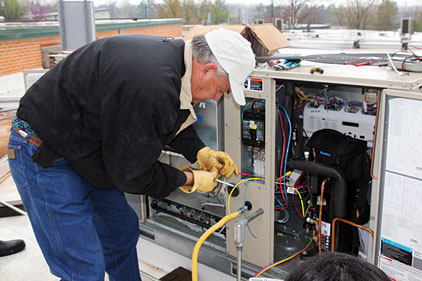SELLERSVILLE, Pa. — Alpine Mechanical Services has announced the completion and results of a collaborative energy efficiency study on rooftop units conducted by Alpine Mechanical, Siemens Industry, and Nexant. The study tested the efficacy of HVAC preventative maintenance best practices in a retail environment. A big box retailer in Austin, Texas, was the test site. Testing was conducted during the hottest months of the year, from Aug. 2, 2013 to Sept. 30, 2013.
The study objectives were to demonstrate how an HVAC tuneup and efficiency could be quantified into a corresponding investment in energy efficiency for rooftop units, both for small retail and big box stores. It tested whether retailers would actually save money and energy by minimizing their risk of equipment failure and reducing service calls, while also maximizing utility rebates in the process.
The scope of work included:
• HVAC equipment — retailer’s existing rooftop units.
• Energy management system (EMS) — providing remote, multi-site operations HVAC control.
• HVAC Service Assistant — a diagnostic tool that allowed technicians to diagnose and detect maintenance problems specific to the heating and cooling systems.
• Re-commissioning of existing rooftop units — which provided a full-service upgrade and HVAC fine-tuning, bringing the unit back to its original factory performance levels.
Mark Barraclough, president, Alpine Mechanical Services, said, “Our challenge was two-fold. First, maintaining a comfortable store environment requires proper HVAC maintenance, which often means the property manager decides between a proactive maintenance program and a reactive approach to maintaining their rooftop units. Cost to provide a quality program versus cost to respond only when repairs are needed is often the deciding factor. The second challenge lies in helping retailers understand that deferring preventative maintenance actually increases their overhead and their emergency service visits.”
The results showed that the rooftops units on the test site that were properly restored, maintained, and cleaned over the course of the two-month study used less energy (kWh) and operated at peak efficiency levels as predicted, as compared to the same period the previous year. In addition, outside air temperatures (OSA) during the same timeframe in 2012 were slightly cooler than in 2013, during which the preventative maintenance program was being conducted. The actual difference in energy usage as compared to the same period in 2012 was 4,251 kWh across all rooftop units. Allowing a 10 percent weather adjustment, the site experienced 3,826 kWh savings over that period. Annualized out, it is an estimated savings of over 35,000 kWh.
With the implementation of the preventative maintenance program, the energy savings achieved also qualified the retailer for utility company rebates. Customers and employees reported a marked difference in store temperature comfort levels, improving internal and external customer satisfaction.
For more information, visit www.alpinems.com.
Publication date: 6/9/2014
Want more HVAC industry news and information? Join The NEWS on Facebook, Twitter, and LinkedIn today!


Report Abusive Comment